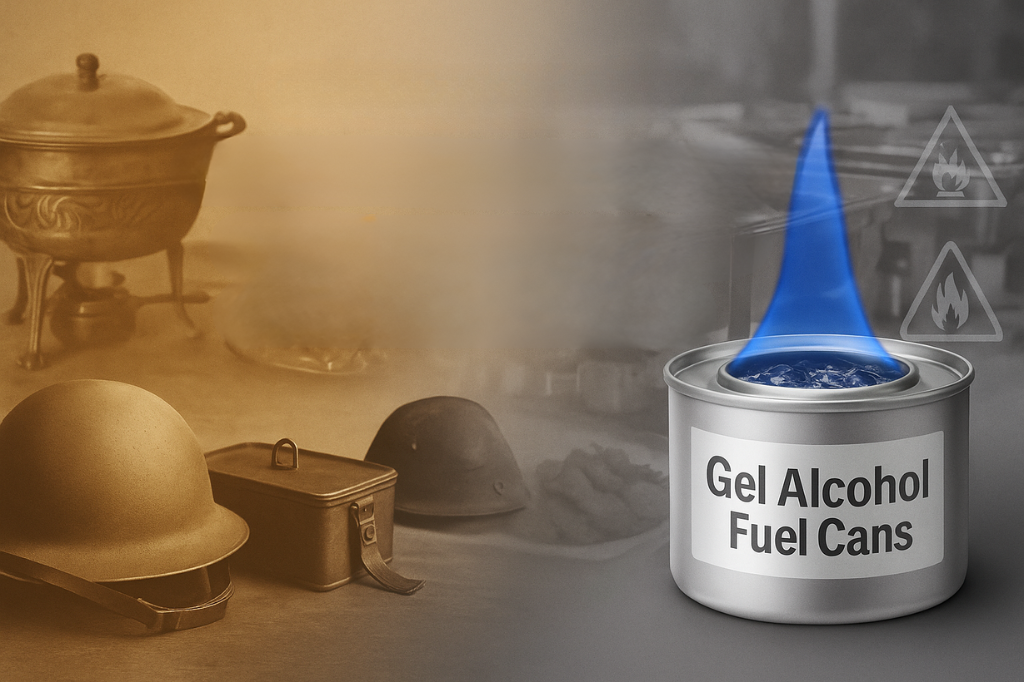Your cart is currently empty.

Origins and Historical Development of Gel Alcohol Fuel Cans
Gel alcohol fuel cans, commonly referred to as Sterno or "canned heat," have a rich history that dates back to the early 1900s. The origins of these portable fuel sources trace back to S. Sternau & Co., a Brooklyn-based company in the United States. In 1900, the company developed a jellied alcohol fuel to complement their chafing dishes and portable stoves. This innovation, later branded as Sterno, used ethanol that was gelled with methanol and other agents to make it undrinkable.
World War I and Military Use
By the time of World War I, Sterno's "canned heat" found its place on the battlefield, providing soldiers with a portable stove option. It continued to see widespread use in the military, especially during World War II, where small tins of gelled alcohol were issued to heat rations. However, these products did face limitations, such as fuel evaporation and leakage at high temperatures.
Post-War Commercial Use
Post-war, gel fuel cans became commonplace in the food service industry, especially for keeping foods warm under buffet chafing dishes and fondue pots. By the mid-20th century, Sterno and similar products were the standard in Western catering, prized for their portability and ease of use. Over time, manufacturers improved formulations, incorporating color dyes for safety and optimizing burn times.
Modern Developments and Alternatives
In recent years, some companies have introduced greener alternatives, such as glycerin-based and flameless heater packs, to address safety concerns. However, traditional gel fuel cans are still widely used in hospitality.
Dangers and Documented Accidents
While gel alcohol fuel cans are convenient, they pose significant safety hazards when not handled correctly. One of the most dangerous aspects of these devices is that the flame produced by burning alcohol gel can be nearly invisible, leading to accidental burns or fires. In fact, if a can is knocked over, the burning gel may spill and stick to surfaces or skin, similar to napalm, causing severe burns.
Tragic Accidents Involving Decorative Firepots
A particularly tragic set of incidents occurred with pourable gel fuels used in decorative firepots. In the early 2010s, several accidents were reported where refilling a not-quite-extinguished firepot led to explosive flares and sticky flames. This prompted a 2011 U.S. Consumer Product Safety Commission recall, affecting over 2 million units after more than 60 accidents, including two fatalities and 34 hospitalizations from gel fuel fires.
Recent Catering Industry Incidents
Even in the catering world, gel fuel cans have caused accidents. For example, in 2023, an NTSB investigation revealed that a poorly extinguished chafing fuel can cause a major fire aboard a Boston harbor dinner cruise, leading to $3.1 million in damages (fortunately with no injuries). Other hazards include personal burn injuries from moving or refilling lit cans, and the toxic ingestion risk posed by the methanol used to denature the alcohol. During the 1920s–1960s, people desperate for alcohol would drink Sterno, leading to methanol poisoning and blindness, with one outbreak in 1963 causing 31 deaths in Philadelphia.
Ingredients and Composition of Gel Fuel Cans
Gel alcohol fuel cans are primarily composed of alcohol (either ethanol or methanol), a gelling agent, and safety additives. Methanol is commonly added to denature the alcohol, making it toxic to drink.
Traditional Formulations and Gelling Agents
The traditional formulation, such as Sterno, combines alcohol with water and an amphoteric gelling agent like calcium acetate, which thickens the alcohol into a semi-solid gel. Some other products may use gelling agents like methylcellulose or polyacrylate polymers, similar to those in hand sanitizers.
Color Coding and Safety Additives
These gels are packaged in small metal cans with resealable lids, often color-coded to distinguish between different fuel types. For example, ethanol-based gels are typically pink, while methanol-based gels are blue. This color-coding serves both as an identification tool and as a visual warning to prevent accidental misuse.
Alternative Fuel Sources
While gel fuels dominate in the catering industry, alternatives such as liquid chafing fuels based on glycols (like diethylene glycol or propylene glycol) are sometimes used. These liquids, which require a wick to burn, are considered safer because they are less likely to ignite if spilled. However, they are still toxic if ingested and should never come into contact with food.
Inhalation Fumes and Health Risks
When gel alcohol fuels burn, they produce carbon dioxide and water vapor, which are considered "clean-burning." However, in real-world use, incomplete combustion can lead to the release of hazardous byproducts, including formaldehyde and benzene, both of which are carcinogenic.
Toxic Byproducts and Health Concerns
A study by the Fraunhofer Institute in Germany found that ethanol and gel fuel burners can release harmful substances such as formaldehyde at concentrations up to 0.45 ppm, well above recommended indoor air quality guidelines. Formaldehyde is a known respiratory irritant and carcinogen, while benzene is linked to leukemia and other cancers.
Ventilation and Exposure Risks
While typical use in large, well-ventilated spaces (such as banquet halls) likely results in minimal exposure, prolonged exposure in smaller or poorly ventilated areas could present health risks. Therefore, it is crucial to use gel alcohol fuels in well-ventilated areas to minimize exposure to these toxic fumes.
Regulatory and Safety Guidelines in Food Service
Due to their inherent fire and health risks, gel fuel cans are subject to various safety regulations. In the United States, while no federal law specifically bans gel chafing fuels, different fire codes and health safety regulations govern their use. Local fire codes, often based on the International Fire Code or NFPA guidelines, typically restrict the use of open flames in public areas. For instance, California prohibits open flame devices in specific public spaces (e.g., Group A, E, I occupancies) unless granted an exemption by a fire marshal. Catered events using Sterno often require a fire department permit and adherence to strict safety measures.
Global Regulatory Frameworks
In Canada, gel fuels are regulated under the Hazardous Products Act and the Workplace Hazardous Materials Information System (WHMIS), classifying them as controlled substances due to their flammability and toxicity. Safety Data Sheets (SDS) must be provided for all such products. Similarly, the European Union classifies methanol-based chafing gels as highly flammable and acutely toxic under the Classification, Labeling, and Packaging (CLP) Regulation, requiring pictogram labels (flame symbol and skull-and-crossbones) and compliance with REACH chemical safety standards.
Although Europe does not have a unified fire code for buffet fuel use, individual countries require fire risk assessments for events. For example, in the UK, compliance with the Regulatory Reform (Fire Safety) Order 2005 mandates assessing open-flame hazards in venues, often leading to safety measures similar to those in the US, such as proper placement, staff training, and fire extinguisher availability. Some European nations are shifting towards alternative heating methods like electric induction buffet warmers and safer solid fuels due to safety and environmental concerns, with studies (such as those in Germany) raising awareness of indoor air pollution risks from ethanol-based heating.
Safety Guidelines for Users
Fire safety guidelines emphasize training, proper equipment, and vigilance when using gel alcohol fuel cans. Standard safety rules include:
- Proper placement: Cans must be in sturdy holders, away from flammable materials.
- Safe ignition: A long lighter should be used, and one lit can should never be used to ignite another.
- Handling precautions: Chafing dishes should not be carried with lit fuel, and a lid or snuffer should always be available for safe extinguishing.
- Post-use safety: After use, cans should be capped and allowed to cool before disposal, as smoldering cans can ignite trash (such as in the Boston Harbor incident).
From a health regulation perspective, agencies ensure that manufacturers provide proper labeling, hazard warnings, and child-resistant caps on portable fuel containers under laws such as the Children’s Gasoline Burn Prevention Act in the US. The 2011 CPSC recall removed unsafe pourable gel fuels from the market, leading to the current standard of sealed, non-refillable gel fuel cans to prevent accidents.
Food Safety Considerations
Food safety regulations prohibit direct contact between chafing fuel and food. The standard setup ensures that the flame heats water, which in turn warms the food, preventing contamination. Strong odors are avoided to maintain food integrity, and any accidental fuel spill into food requires immediate disposal per health regulations. Fortunately, proper equipment use minimizes these risks.
Conclusion
Gel alcohol fuel cans, such as Sterno, are widely used in food service and catering but come with significant hazards. The risks include invisible flames, burns, toxic fumes, and fire hazards, necessitating strict safety protocols. Regulatory frameworks in Western countries aim to mitigate these risks through hazard classification, labeling, training, and proper use guidelines. While these fuels remain convenient and portable, adherence to safety rules is essential to prevent fires, injuries, and poisoning incidents. As fire marshals emphasize, improper use of chafing fuel can lead to severe accidents, making oversight and education critical in food service settings.
When considering alternative heat sources, it’s important to evaluate both safety and efficiency. For instance, electric induction warmers and butane burners can offer safer, cleaner options for warming food without the risks associated with gel fuels. These alternatives often provide more control over temperature and are less prone to dangerous flare-ups, making them a viable choice in environments where safety is a top priority.








